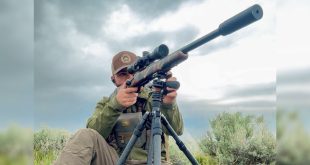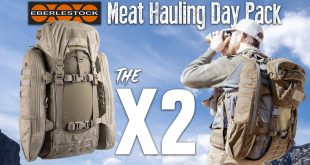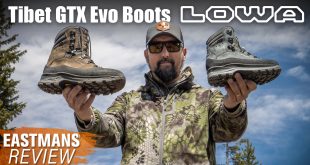
What if there was one item that would give you more endurance? One item that allowed you to go more miles and made gaining or losing elevation easier? What if there was one item that kept you safer in the mountains and put less wear and tear on your body? No, it is not some new super-steroid on the market, horse or hovercraft – they’re trekking poles.
Trekking poles are not just for bunny lovers and tree huggers, us hardcore hunters can use and benefit from them immensely. I have seen a few guys using them for goat and sheep hunts but I rarely see anybody taking advantage of poles for the mainstream hunts like elk and deer. Trekking poles allow you to gain twice the miles with half the soreness the next day. If you are not using them, you are giving up a major advantage in the backcountry!
Pros and Cons
The biggest advantage I (Brian) get out of trekking poles is I can check off more miles with less effort. My circle of hunting buddies all know the benefits of using poles and they rarely show up without them. That’s the best way to see the how trekking poles make hiking easier, have a buddy hike with them and you hike without them and try to keep up. It’s like they’re cheating – their pace is faster, they climb quicker and overall have more energy at the end of the day. When I show up to meet someone and they have the sticks and I don’t, I know I am in for a tough day, even if I am in better shape.
I have young legs and get around the mountains pretty well but I can guarantee as I get older I will have a set of trekking poles nearly everywhere I go. It will help even the playing field with the youthful go-getters out there. Trekking poles also help stabilize you on uneven ground and puts less wear and tear on your joints. Going downhill is tough on our bodies, we all know that. The pounding and pressure is put on our knees, hips and back. Trekking poles help brake your momentum going downhill and ease the pounding. Think of it as more of a controlled decent where your body does not take as much of a beating.
Whether you are young or old we can all benefit from the stability that trekking poles give us. It makes the tough hunts safer. While using trekking poles there is going to be less chance of twisting your ankle or knee, or worse yet, taking a bad fall with a loaded pack. Trekking poles help grip on steep or loose terrain and keep you upright.
I had one hunting season where I had overdone my training. For guys that do not know me, I live eat, sleep and breathe extreme hunting. Coming into hunting season I did one too many road marathons. The pounding on the pavement left me with an IT band injury in my knee. It was the worst injury I have ever sustained and left me wondering if I would lose the entire season. Trekking poles saved me and allowed me to continue with my season and extreme hunts. I ended up harvesting an awesome above-treeline muley in the most demanding, extreme wilderness Montana has to offer. I attribute my success that season to trekking poles. I could not have done it any other way.
Okay, so I have given you all the positives to trekking poles, now I will shoot you straight on the downsides to trekking poles. The “clang”, “tink” and “clack” of trekking poles drives me nuts. There is an audible metal sound when you plant on rocks or when your poles hit together. You can send game running for miles with these sounds. Most trekking pole companies make rubber boots to help quite things down. I recommend buying a couple pairs as they seem to wear out quickly. The other thing I do is to use them to get miles deep into the wilderness but when I am sneaking around looking for critters, I will put them in my pack.
Another downside to using trekking poles is you have to attach your weapon to your pack. Now it does not bother me to not have quick access as much as I just don’t like the extra 6 to 10 pounds on my back. For me, it’s a downside but I have found the benefits I get out of the poles is worth it.
Trekking Pole Techniques
Alright, if you have made it this far in the article I have convinced you of the benefits of trekking poles for extreme hunting. Now that you plan on using trekking poles I want you know how to use them correctly.
It will come pretty naturally to use the opposite arm to leg when you are hiking because it matches our natural gait. The most important part is to load the poles. You want to make sure you are using your upper body to drive on your poles. If you are not loading your poles you are just exerting extra energy. We call it coasting, which is okay on easy downhill or level ground but do not make a habit of it all the time. You need to be driving forward to see the benefits of trekking poles and you should feel like you got your upper body a workout at the end of the day. If you are hiking five miles you have to exert five miles of energy no matter how you do it. The difference is with trekking poles you spread the five miles over your entire body instead of just on your legs.
Braking going downhill is another technique you will have to master. This is where you want to plant the trekking pole out in front of you to slow down your decent. I like to switch my grip from around the vertical grip to my hand on top of the trekking pole as it seems to give me better control and bracing.
Using trekking poles comes pretty natural as long as you have things set up correctly. By correctly I mean the right height. Almost all trekking poles now days have adjustable length and for good reason. When you initially set up your poles, set them so your arm makes a 90-degree bend. Then adjust them for the terrain you are on. For downhill, you want them longer so you can plant out in front of you. For uphill, use a little shorter and pull uphill. Then, for long side-hilling, you want your uphill pole short and your downhill side long. Making these quick adjustments to your poles keeps you stable and ensures you are getting the most out of your sticks.
I also have a couple bonus techniques for you to try when you are out in the field. Resting on your trekking poles would not seem like that big of deal but it helps a bunch. On a long, grueling climb or long hike into base camp, there is nothing better than being able to stop, rest and lean over your poles. It is so nice to be able to get a quick break in without taking off your pack and sitting down.
Another way I like to use my trekking poles is to use them as a monopod to put my binos on. I will kneel down and set my binos on top of them for stabile glassing. If I really want to look over a feature I will sit down, adjust my pole to the right height, and then dissect the hillside.
Trekking poles are a major staple in my diet of extreme hunts. I have a huge hunting season planned this year starting with 10 days in Nevada for above treeline mulies. Last year I harvested my buck over 20 miles from the trailhead. Next up is 10 days in the Colorado high country for mulies. My Colorado spot is some of the most remote, gnarly country I have ever hunted. It is littered with 13,000 and 14,000-foot peaks and over 30 square miles without even a horse trail through it.
Next up my Dad drew his Montana mountain goat tag this year in our backyard wilderness, the Madison Range. Mountain goat hunting in Montana is guaranteed to be lots of miles and definitely in steep, extreme country.
As you can see my season starts with a bang of tough hunts. I will be logging hundreds of miles and thousands of feet of elevation, all leaning on my trekking poles. If you want to get more out of your hunting days and more out of your legs, pick up a pair of trekking poles to try out this season. With that, let’s kick it over to Aron and see what type might be best for you.
Aron – Trekking poles are somewhat of a necessary evil when backpack hunting and as Brian has mentioned already, they can be worth their weight in gold on the mountain.
Since Brian has covered pros, cons and different techniques, I will touch on the different styles and other uses and recommend a few options as well.
Styles of Trekking poles
You would think buying a set of trekking poles would be a relatively simple task but in today’s high-tech hunting world you’ve got enough options to confuse the highest tech redneck on the mountain! I’ll go ahead and list some of the major differences between the models as well as some of their pros and cons.
- Twist Lock vs. Lever Lock vs. Foldable – I’ve used all of these types at great length and if I had to choose one style, it would be the lever lock. They seem to be a bit more durable and the levers hold better as well. You can always get the foldable type if you’re worried about them compressing but you’ll lose the option of large height adjustments with the foldable models, so keep that in mind.
- Aluminum vs. Carbon – Like anything in life, choosing between these two materials will highly depend on each user but from my experience you can’t go wrong with either type – if they’re high quality. You’ll save a bit of weight with carbon models, everything being equal, but the argument could be made that aluminum will last longer.
- Standard vs. Ice Axe – They can be pretty hard to find and very few companies make them, but walking sticks that double as an ice axe/fall arrest system are pretty badass in the right situation. If I’m not doing anything too crazy, I always use a standard set of sticks but if I’m heading into rough country, you can bet on me having an ice axe model in my hand as I only bring one.
Now that I’ve covered some of the basic style and options, let’s look at what else a trekking pole can be used for.
- Floorless shelters have become a huge part of weight savings for today’s backpack hunter and a lot of that weight savings has to do with using trekking poles to help erect the shelter. Since most people are packing a trekking pole/poles anyway, you may as well use them to hold up your shelter too.
- With a little ingenuity, trekking poles can be used as a rifle rest/shooting stick if you plan ahead. There are actually a couple models available that have a V built into the top to use as a monopod shooting stick. This isn’t a huge selling factor for me but if it adds another use, all the better.
- As I mentioned above, I take an ice axe trekking pole when in rough terrain and sometimes need to use it to dig out a bed for my sleeping area. It works pretty well for leveraging large rocks out of the ground and helps smoothing out the surface too.
- Another thing the ice axe model is good for is digging a trench for a water trough. This may seem like a simple thing but when your only water source is a small trickle, digging a trench and water pool can be a lifesaver.
- Several of my hunting partners have started using gravity filters for water filtration but using them above treeline can be a problem with nothing to hang them on. When this situation arises, we take three trekking poles and build a tripod to hang the gravity filter from. Again, this probably doesn’t seem like a big deal but it’s been a huge asset for us when hunting above 12,000 feet.
I’d like to tell you that I haven’t spent a small fortune trying out all the different models of trekking poles on the market but that would be a lie! So luckily for you I’ve done a lot of the footwork and can recommend a few models that won’t let you down.
- Easton Hike Carbon 3 – These have been in my pack since they were introduced and are always my first recommendation for a standard trekker.
- Stubai Tour Lite – I’ve only been using this model for a year but for an ice axe model, it’s at the top of the list.
- Grivel Condor – This model is a modified ice ace trekker but has some unique features to it, so depending on the situation, it may be a great option for an ice axe trekker.
- Black Diamond Z Pole – There’s a few different types of Z poles but if you’re going to be going ultralight, these are a great option.
There are many other great trekking pole options on the market today and most of them are going to serve you well. Just make sure and have them along with you, as they will save your knees, back and body but also add some additional help along the way.
 Eastmans' Official Blog | Mule Deer, Antelope, Elk Hunting and Bowhunting Magazine | Eastmans' Hunting Journals
Eastmans' Official Blog | Mule Deer, Antelope, Elk Hunting and Bowhunting Magazine | Eastmans' Hunting Journals





Agree!! I use my sticks on all of my hunts and hikes. Balance, safety, endurance are all positive results. The best sticks I’ve used are from Costco, $30/pair. You definitely want the clamp type.